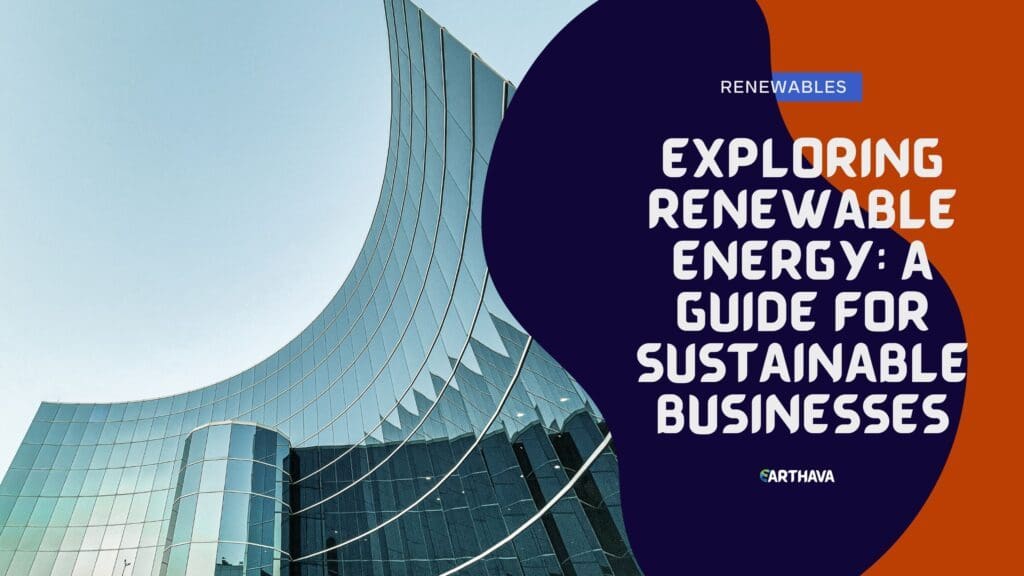In 2017, 18% of the electricity used by the United States came from renewable sources. Up 3% from 2016, this figure is double the amount of renewable energy consumed just 10 years earlier.
Despite indications from the Trump administration that funding for renewable energy could be reduced, market forces will ensure the renewable trend continues. In fact, by 2021, solar energy will cost less than coal.

Read on to learn more about the different types of renewable energy and how they can make your business more sustainable.
Solar Power
Photovoltaic systems rely on solar cells to capture energy directly from the sun. These systems represent the most recognized forms of solar energy. But there are many other innovative ways to harness the power of the sun’s rays.
Let’s take a look at some that are having significant positive impacts on businesses across the country.
For example, buildings can be heated with a solar hot water system. This system circulates water through flat-plate solar collectors.
Industrial and commercial buildings can also use this solar power strategy to heat, cool, and ventilate on a larger scale.
The sun’s rays can be collected and concentrated via mirror-covered dishes to boil water. A conventional steam generator uses the steam from the boiled water to create energy.
Other business uses of solar power include installing a commercial solar power system. That way, your enterprise can participate in a solar power purchase agreement (PPA).
Wind Power
When turbines get turned by wind flow, they capture the energy produced and convert it into electricity. This concept comes from the much older and smaller-scale practice of using windmills to pump water on farms.
But how can wind power help your company become more sustainable? Avariety of commercial-grade wind power generating systems are readily available. The energy from these systems can help offset your enterprise’s electricity costs.
For example, you can use the electricity created by single-wind turbines to decrease your utility costs. Or, you can purchase electricity from a wind farm through a wholesale power market.
Either way, you’re helping the environment and your bottom line. Does it get any better than that?
Geothermal Power
Besides solar and wind power, geothermal energy represents another renewable energy source. How? It utilizes energy from heated rock and hot water reservoirs located deep beneath the earth to create electricity.
From small-scale geothermal heat pumps to large-scale power plants, there are many ways to leverage the constant heat source lurking below the surface of our planet.
Geothermal power can help grow greenhouse plants, too. It gets used to warm water at fish farms. And it’s even used to heat manufacturing plants and buildings.
Finally, some members of the dairy industry rely on geothermal power during the process of pasteurizing milk.
Hydroelectric Power
You’re probably familiar with hydroelectric power plants such as Hoover Dam. They rely on dams to trap water in reservoirs.
This water is then released from one reservoir to another. In the process, the water passes over trbines, creating electricity.
As the water flows over the turbines, it generates electricity. The term for this is “pumped-storage hydropower.” To control electricity generation based on consumer demand, water passes from lower and upper reservoirs.
Hydroelectric power plants vary in size from micro-hydroelectric power systems to massive projects like the previously mentioned Hoover Dam.
There are also plants known as “run-of-river hydropower” facilities. Here, dams aren’t required. Instead, energy is generated by funneling part of a river through a channel.
Small towns use moderately-sized hydroelectric power plants to harvest the energy of local waters. Micro-hydroelectric plants are great for powering agricultural operations such as farms and ranches.
Bioenergy
Bioenergy is a renewable energy source that comes from materials such as:
- Forest debris
- Scrap lumber
- Some crops
- Some types of waste residues
- Manure
As you can see from the list above, biomass refers to any organic matter from once-living plants and animals. Although bioenergy creates about as much carbon dioxide as fossil fuels, there’s one huge difference.
In order to produce replacement matter once it’s burned, you’ve got to grow more plants. These plants end up removing about as much carbon dioxide from the air as bioenergy creates. So, the overall environmental impact remains minimal.
Biomass materials are used to produce liquid fuels for transportation. These include biodiesel and ethanol. Biomass can also be used to create heat for other types of energy.
Besides burning biomass, you can let it decompose. During this natural decomposition process, methanol gas is produced, which can also be captured and used as energy.
Hydrogen Power
The most abundant element on the planet, hydrogen is found in organic compounds. Some algae and bacteria also produce it under the right conditions. While high in energy, hydrogen creates almost no pollution.
This makes it an excellent element to harness as renewable energy. You can use hydrogen fuel cells to convert the chemical energy into electricity. The byproducts of this process are heat and pure water.
Hydrogen energy can power marine vessels. Large hydrogen fuel cells also provide a source of electricity for buildings and remote locations.
But the price of hydrogen cells proves cost-prohibitive for many businesses. That said, watch for innovations and developments in this area of research to help bring costs down in the near future.
Types of Renewable Energy
You’ve probably heard more about solar and wind energy than any of the other types of alternative energies on this list. But, they’re all poised to have continued positive impacts on the future of energy.
Now that you have a better understanding of the types of renewable energy available, how will you work to make your company more sustainable?
Not sure? We can help.
At Earthava, LLC, we specialize in helping people realize the importance of renewable energy sources and environmental conservation. Continue reading our blog to learn more about renewable energy and how it can power your future.


